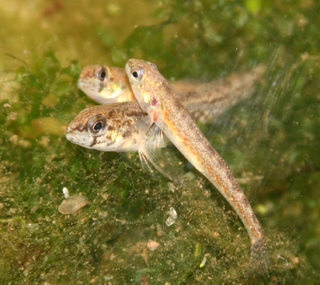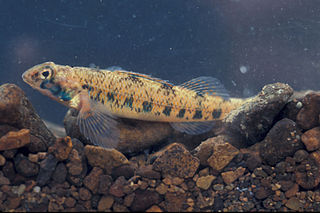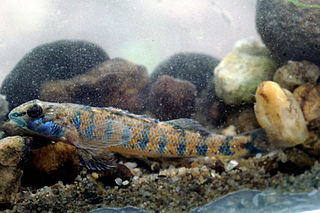
Ammocrypta is a genus of freshwater ray-finned fish, commonly known as the sand darters, which is classified in the subfamily Etheostomatinae, part of the family Percidae which also includes the perches, ruffes and pikeperches. The species in the genus occur in eastern North America in Canada and the continental United States.

The eastern sand darter is a species of freshwater ray-finned fish, a darter from the subfamily Etheostomatinae, part of the family Percidae, which also contains the perches, ruffes and pikeperches. The eastern sand darter is a relatively small fish, most plentiful in the Mississippi and Ohio Rivers, as well as Lake Champlain and the Great Lakes. It prefers sandy-bottomed streams and sandy shoals in the lakes. The eastern sand darter feeds on larvae of black flies and other small insects in the water. They also feed on zooplankton in small portions since their small mouth size limits their gape ability. Its average body size is around 1.5-2 in long, and it breeds in the spring and summer in sandy-bottomed waters.

Gobitrichinotus is a genus of sand darters, with one species from rivers in Madagascar and another from coastal waters of the western Pacific Ocean.

The channel darter is a species of freshwater ray-finned fish, a darter from the subfamily Etheostomatinae, part of the family Percidae, which also contains the perches, ruffes and pikeperches. It is native to North America where it typically occurs in the sandy or gravelly shallows of lakes and in small and medium-sized rivers in riffles over sand, gravel or rock bottoms. It is a small fish ranging from 34 to 72 mm in length, olive brown with darker speckles and sometimes with a dark spot below the eye and dark blotches along the flank. It feeds mostly on insect larvae and other small invertebrates and breeds in small streams. This species is listed as threatened by the Canadian Species at Risk Act (SARA) but overall it has a wide range and numerous sub-populations and the International Union for Conservation of Nature has rated it as a "least concern species".

Pseudotrichonotus is a genus of fish in the family Pseudotrichonotidae native to the Indian and Pacific Ocean. This genus is the only member of its family.

The scaly sand darter is a species of freshwater ray-finned fish, a darter from the subfamily Etheostomatinae, part of the family Percidae, which also contains the perches, ruffes and pikeperches. It is endemic to the southeastern United States. It is found in the coastal plain area of the Mississippi River basin, typically in medium-sized streams with slow currents over sandy substrates where it feeds on midge larvae and other small invertebrates. The slender body is semi-translucent, yellowish with a dozen or so dark bars. This fish has a wide range and is relatively common, and the International Union for Conservation of Nature lists it as a "least-concern species".
Myxodagnus is a genus of sand stargazers, native to the Pacific and Atlantic coastal waters of the Americas.

Etheostoma exile, the Iowa darter, is a species of freshwater ray-finned fish, a darter from the subfamily Etheostomatinae, part of the family Percidae, which also contains the perches, ruffes and pikeperches. It is, along with about 17 other species of darters, is native to the lakes and streams of Iowa.
The naked sand darter is a species of freshwater ray-finned fish, a darter from the subfamily Etheostomatinae, part of the family Percidae, which also contains the perches, ruffes and pikeperches. It is found in the south-eastern United States.

The western sand darter is a species of freshwater ray-finned fish, a darter from the subfamily Etheostomatinae, part of the family Percidae, which also contains the perches, ruffes and pikeperches. It is native to the central United States.

The blueside darter is usually found in the Tennessee River drainage in Tennessee, Alabama, North Carolina, and Virginia, and less commonly found in Bear Creek, Shoal Creek, and Barren Fork.

The speckled darter is a species of freshwater ray-finned fish, a darter from the subfamily Etheostomatinae, part of the family Percidae, which also contains the perches, ruffes and pikeperches. It is endemic to the central and southeastern United States. It occurs in the Mississippi River basin and through the Gulf Coast drainages. It is also found in the Clinch River and the Powell River. This species inhabits rocky or sandy pools in flowing waters up to the size of medium rivers with fast currents. It can reach a length of 6.1 centimetres (2.4 in) TL though most only reach about 4 centimetres (1.6 in).
Macroparalepis is a genus of barracudina.
Sudis is a genus of barracudinas, with two currently recognized species:
Rosenblattichthys is a genus of pearleyes.
Cetichthys is a genus of flabby whalefishes.
Chalixodytes is a genus of sandburrowers native to the Indian and the Pacific oceans.

The Florida sand darter is a species of freshwater ray-finned fish, a darter from the subfamily Etheostomatinae, part of the family Percidae, which also contains the perches, ruffes and pikeperches. It is endemic to Gulf Coast drainages from the Aplalachicola to the Perdido River in Florida and southern Alabama. It inhabits streams with waters that are clear to tannin-stained where there are shifting sand bottoms and a moderate to fast flow. It is most frequently encountered where there is a moderate current in medium-sized to large streams, but it will enter smaller streams on occasion. Its appearance is identical to the naked sand darter aside from 2 black bands on each dorsal fin. This species can reach a length of 7.1 cm (2.8 in), though most are only about 4.7 cm (1.9 in) in length, at depths of 61 to 122 centimetres. The Florida sand darter was first formally described in 1975 by James D. Williams with the type locality given as the Choctawhatchee River, 2.4 kilometres (1.5 mi) west of Pittman, Florida. This species forms a clade with the naked sand darter the Western sand darter.

The Savannah darter is a species of freshwater ray-finned fish, a darter from the subfamily Etheostomatinae, part of the family Percidae, which also contains the perches, ruffes and pikeperches. It is endemic to the eastern United States, where it occurs in the Edisto, Combahee, Broad and Savannah River drainages in South Carolina and Georgia. It inhabits gravel riffles, gravel and sand runs of creeks and small rivers. This species can reach a length of 7.4 cm (2.9 in).
The southern sand darter is a species of freshwater ray-finned fish, a darter from the subfamily Etheostomatinae, part of the family Percidae, which also contains the perches, ruffes and pikeperches. It is found in the rivers draining into Mobile Bay in the southeastern United States where it inhabits sandy sections of flowing waters from streams to large rivers.











